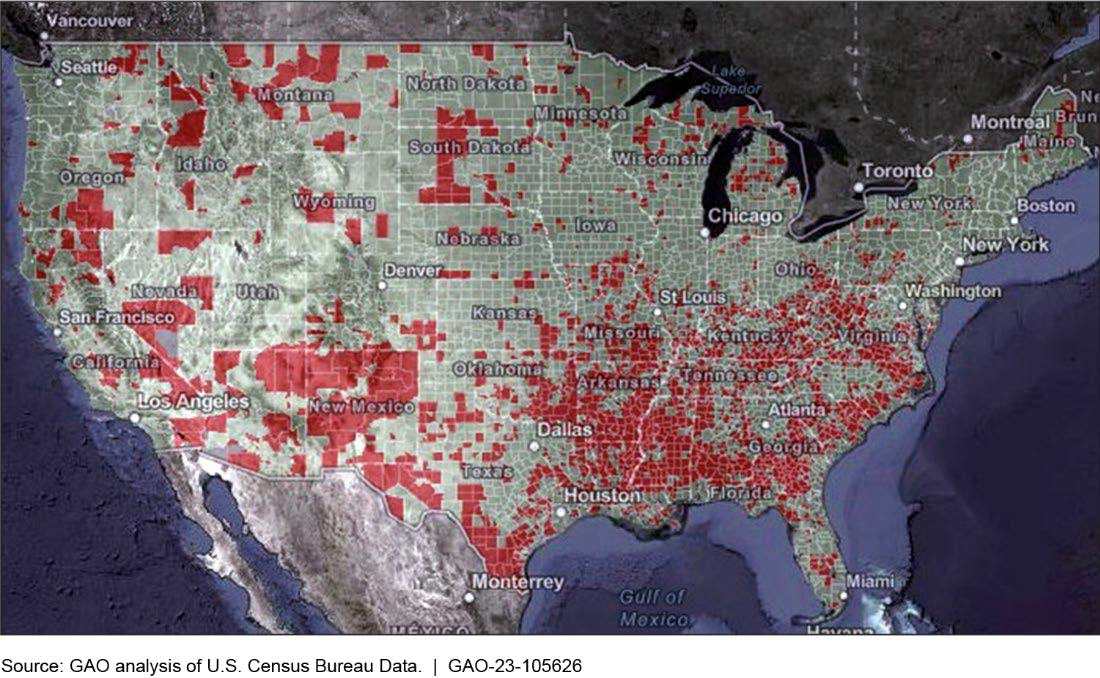Telecommunications Workforce: Additional Workers Will Be Needed to Deploy Broadband, but Concerns Exist About Availability
Fast Facts
Recent legislation included big increases in federal funding for the deployment of broadband, which is increasingly critical to daily life, but unavailable in some areas.
Our analysis found that thousands more skilled workers will be needed to deploy broadband and 5G funded by recent federal programs. If this work is spread over 10 years, at its peak, the funding would support about 23,000 additional workers. A shorter timespan could require even more of them.
We found mixed evidence on whether there's a shortage of these workers. Their unemployment rate was low, but we didn't observe wages going up in this area, which would suggest a shortage.
Types of Fixed Broadband

Highlights
What GAO Found
Broadband has become critical for daily life as everyday activities like work, school, and health care appointments increasingly occur online. However, at least 25 percent of the population in many areas reported not having broadband service, according to the U.S. Census Bureau's 2020 American Community Survey (see figure).
Figure 1: 2020 U.S. Census Bureau Data Showing Locations (in Red) With At Least 25 Percent of the Population Reporting No Internet Access

Congress has found that access to affordable, reliable, high-speed broadband is essential to full participation in modern life in the United States and recent federal legislation included tens of billions of dollars in federal funding for broadband deployment.
GAO found that thousands of additional workers would be needed to build the amount of infrastructure associated with such increases in funding from eight selected broadband infrastructure deployment programs. GAO found that the pace at which these programs provide funding will impact the annual number of additional workers needed. For instance, if funding is provided over a 10-year span, GAO estimates that about 23,000 additional workers could be supported by the peak year of funding in 2023, declining to about 9,000 additional workers in 2031 due to the impact of inflation and because funds for some programs must be expended before 2032. The shorter the time-frame over which federal funds are provided, the more workers will be needed per year. Assuming a 5-year funding time period, for example, about 34,000 additional workers would be needed by the peak year of funding in 2023.
GAO found mixed results from analysis of three indicators related to occupational labor shortages: (1) unemployment rate; (2) employment levels; and (3) wage growth rate. These indicators are from IPUMS Current Population Survey data regarding occupations GAO selected on the basis they are necessary for deploying broadband infrastructure. GAO found that unemployment rates for most of the selected occupations were lower than the national average, which is suggestive of a possible labor shortage. However, GAO did not find observable increases in employment levels and wages for the selected occupations as also would be expected in the presence of labor shortages.
Industry stakeholders GAO spoke with expressed concerns regarding the ability of the broadband infrastructure deployment industry to attract sufficient numbers of workers needed to deploy broadband infrastructure funded by selected federal programs. Their concerns included uncertainties regarding: (1) the sufficiency of workers available particularly in rural areas; (2) the extent of competition from other industries for occupations necessary to deploy broadband infrastructure; and (3) the adequacy of the general supply of new entrants into broadband deployment-related occupations.
Why GAO Did This Study
As highlighted by the COVID-19 pandemic, broadband is vital for daily life, and recent statutes funded various federal programs to ensure all Americans have access to broadband. The Infrastructure Investment and Jobs Act included a provision for GAO to review and estimate the number of skilled telecommunications workers that will be required to build and maintain broadband infrastructure in rural areas based on current and potential need, as well as the wireless infrastructure needed to support 5G wireless technology.
Accordingly, this briefing describes: (1) the estimated number of additional skilled telecommunications workers needed to deploy broadband and 5G funded by certain recent federal programs; and (2) what existing data reveal about a potential labor shortage for skilled telecommunications workers, as well as stakeholder views on workforce concerns relevant to these skilled workers.
To address these objectives, GAO reviewed applicable statutes and regulations, as well as official documentation for eight federal programs we selected, and used the Bureau of Labor Statistics' 2020 employment requirements table data to estimate the number of additional workers supported by each additional $1 million in program funding.
GAO also initially selected 10 Bureau of Labor Statistics-defined occupations and subsequently obtained IPUMS Current Population Survey data files for each on unemployment rates, employment levels, and wage growth rates. GAO compared these data against the unemployment rates, employment levels, and wage growth rates for the overall economy for 2010-2021.Increasing employment levels and wages occurring alongside low unemployment rates may suggest the presence of an occupational labor shortage.
In addition to this indicator analysis, to collect a variety of views on workforce concerns regarding deploying broadband infrastructure and 5G to all Americans, GAO interviewed stakeholders from federal agencies, industry associations, companies, and consultants.
For more information, contact Andrew von Ah at (202) 512-2834 or vonaha@gao.gov.
